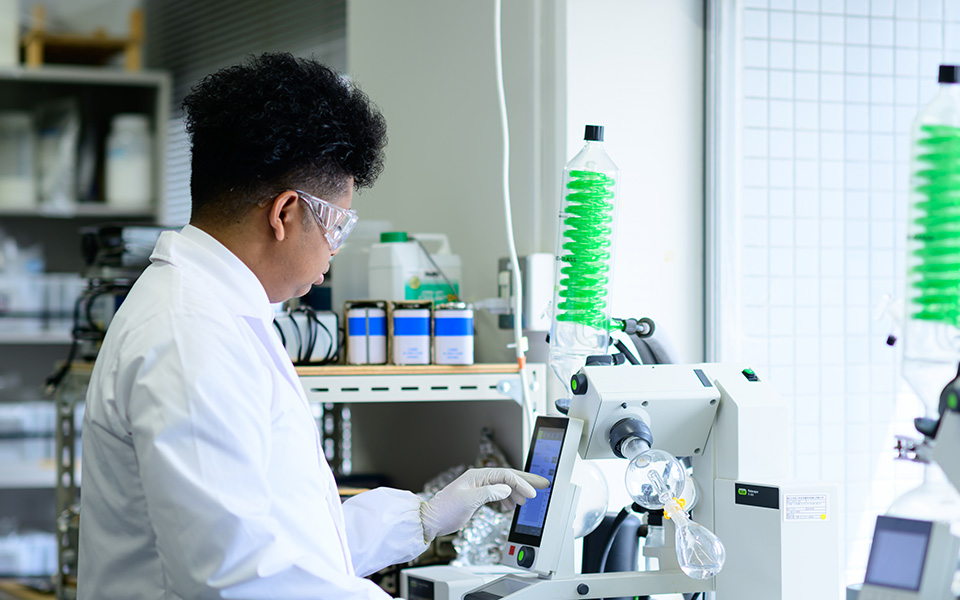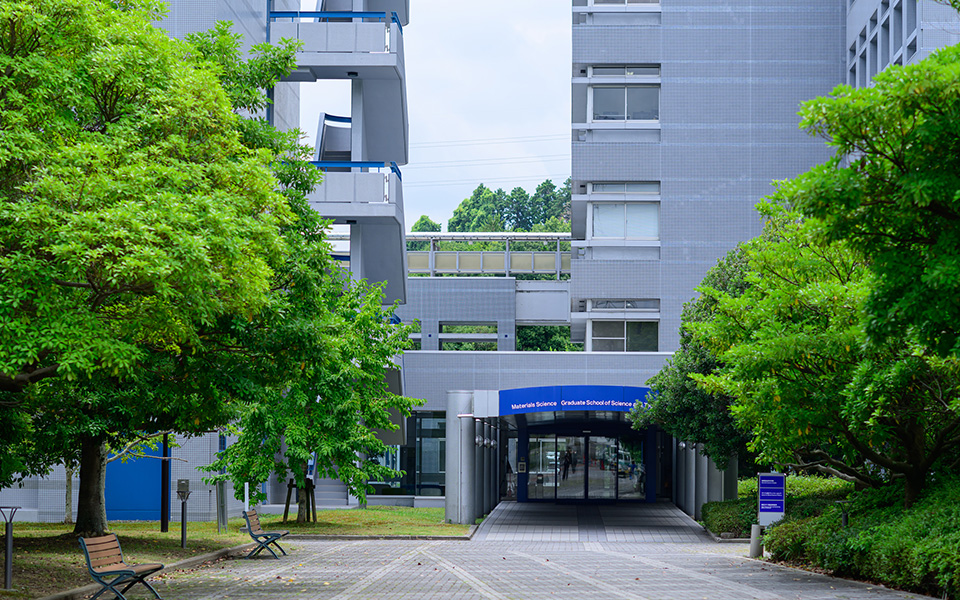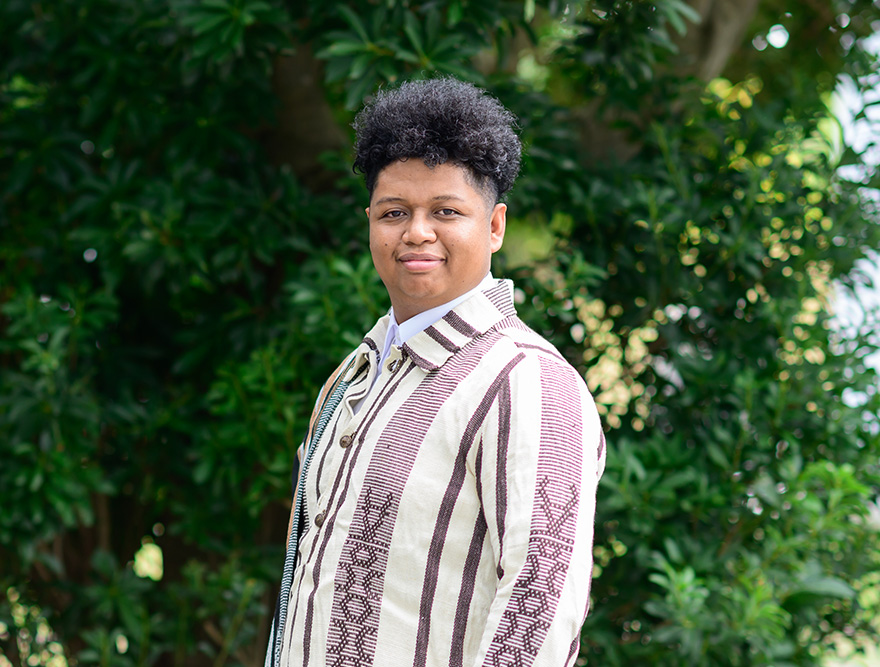How did you join NAIST
During my middle and high school years, I was interested in biodegradable plastics. At that time, plastic waste was everywhere in Madagascar, to the point where it even got mentioned in a popular hit song of that time. There I wondered, “Why do people in this country do this, can’t we change it?” and decided, “OK, when I grow up, I will study biodegradable plastics and solve this problem.” At the time, the concept of the SDGs did not exist, but the problem had already halfway started. I began to think about whether there were materials that could prevent such problems and eventually developed an interest in polymers.
My academic journey began with an early interest in polymer science during my undergraduate studies. I was especially fascinated by the development of polymer coatings and surface functionalization techniques — particularly how we could make utensils and surfaces hydrophobic and non-stick through chemical design. This sparked a curiosity not only in material properties but also in how chemistry could interface with practical, everyday applications.
After my undergraduate degree, I pursued a master's in computational physics, focusing on how surface anisotropy influences the behavior of ferromagnetic materials. It was a shift from polymers to condensed matter simulations, but the common thread was a drive to understand and predict material behavior from a fundamental level. That said, my interest in polymers never left me. I found myself continuously drawn back to questions like: what if we go beyond surface modification? What happens if we manipulate the very nature of the polymer itself — the monomer composition, the bonding patterns and so on. I wanted to understand how those molecular decisions translate into macroscopic properties. That level of inquiry, I believed, could only be pursued in an academic research environment rather than in industry.

During my undergraduate studies, I also started having an interest in Japanese language and learned some of it. It was initially because of my interest in Japanese anime, but as I studied it, I became increasingly drawn to the Japanese culture and technology.
My Japanese teacher suggested that I consider applying for a scholarship to study in Japan since it was difficult to pursue my research in Madagascar due to the lack of facilities and proper laboratories. I was recommended by the embassy and accepted as a government-sponsored international student. Then I began searching for graduate programs in Japan that aligned with my interests. I found NAIST through targeted keywords, and as I explored the faculty profiles and research labs, the Nanomaterials and Polymer Chemistry Laboratory immediately caught my attention. At that time, the lab emphasized its focus on designing functional materials from the molecular level — crafting polymers with specific properties by tailoring their monomers and topologies. That approach matched perfectly with my intellectual ambitions, and I decided to join.
I think 90% of international students find out about NAIST through double degree programs or academic exchange agreements, but for me, it was purely from my own exploration and luck.
Looking back, coming to NAIST wasn’t just about joining a good program — it was about finding a place that encouraged curiosity-driven, interdisciplinary research in an international and collaborative setting.

What is your current research and experiences in your lab
My current research centers on the synthesis and characterization of topological polymers — specifically those without traditional chain ends, such as cyclic or figure-eight-shaped polymers. These are synthesized via dynamic covalent bonds between phenylboronic acid and cis-1,2-diols. While most commercial polymers like PET are made up of linear chains that entangle to form a bulk material. Imagine a tangled bowl of spaghetti, the pastas are just a long strand, and they combine with each other to form the final dish, same for the conventional polymers. For our research, we explore how changing the topology of the spaghetti from a linear strand to one forming a monocycle, or two or more of these circles interacting with each other can affect the properties of final dish, in this case the properties of the polymer. We don’t only affect the chemical composition but the very topology of the polymer also to unlock new functionalities.
For example, by the previously mentioned closed-loop structure (i.e., a polymer ring), we remove the chain ends that often serve as degradation points, potentially leading to enhanced thermal stability, tunable degradation, or even novel viscoelastic properties. This research has implications not only in materials science but also in biomedical and sustainability contexts.
What excites me most is that we’re not just synthesizing new molecules — we’re challenging conventional ideas of what a polymer is supposed to look like. We propose a new approach, using reversible bonds that enable both control and adaptability. It’s an area where chemistry, topology, and materials science all intersect, and that makes every day intellectually stimulating.
Working in my lab has also been a great intercultural experience. Our members are a mix of Japanese and international students, and communication is naturally bilingual. I typically use Japanese when speaking with my professors, although we switch to English when discussing more complex or technical issues. With my lab-mates, we try to bridge the language gap from both sides — Japanese students make efforts to speak in English, and international students, including myself, work hard to improve our Japanese. This mutual effort has created an environment of shared growth, not only in research skills but also in cross-cultural communication.
However, the seniority hierarchy is very strong in Japan. I think that all lab members are on an equal basis, but this is not always the case. When a problem arises, Professor Ajiro holds a roundtable discussion so that everyone can think about how to solve it.
When I first arrived in Japan, my limited Japanese ability made daily communication difficult. However, my professor was very supportive, speaking to me in English during the early stages of my research. Over time, as I improved my Japanese, I was able to interact more freely with my Japanese lab-mates and participate more actively in discussions and experiments. There are still occasional misunderstandings or cultural differences — as in any diverse setting — but I’ve learned that openness, patience, and humor go a long way in overcoming those moments.

How do you evaluate NAIST’s research environment
We conduct research based on experiments, so during our core hours from 9:30 AM to 5:30 PM on weekdays, we focus on tasks such as experiment preparation, equipment calibration, doing experiments, performing analysis, planning for the next day's experiments, and writing reports. Every day is almost the same. I think it is very important to establish a system to support the mental health of faculty members and students who lead such a rigorous research lifestyle.
Our university has excellent research facilities, but I think the lack of facilities for social life is an issue. Before the pandemic, there was a fitness room, but it has since closed. While there are basketball and tennis courts, they are outdoors, so we cannot use them when it rains. There is also no swimming pool. Back in Madagascar, we had such facilities nearby and saw their results, so that’s why I think they are important. I firmly believe that establishing mental health facilities at our university would make a significant difference.
In addition, opportunities for counseling in English are extremely limited, so most of my friends use clinics outside the university. International students are far from their home countries and have come to a completely unfamiliar place. Some don't have friends, others can't share their feelings with those around them, and some have complex backgrounds. Establishing a multilingual counseling system would undoubtedly be helpful. Furthermore, the harassment consultation system is hardly used. I think the reason no one uses it is because faculty members are in a higher position than students, and students may fear that reporting something could cause problems later on. I think NAIST could do something to improve this system in order to fully support students and to support faculty and staff.
One of the most reassuring aspects of studying at NAIST has been the comprehensive support system for international students. When I first arrived in Japan, I knew almost nothing about essential procedures like registering for health insurance, paying taxes, or setting up a bank account. The International Student Affairs Section (ISAS) guided me through each of these steps, ensuring that my transition to life in Japan was as smooth as possible.
NAIST itself is located in a quiet, semi-rural area of Nara, and I’ve come to appreciate this remoteness. The peaceful surroundings are ideal for focusing on research without the distractions of a busy urban life.
At the same time, there’s a vibrant student community. Clubs, language exchange circles, and international events allow for cultural sharing and help break the monotony of daily routines. Whether it’s sports, music, or simply joining a dinner outing, these moments add an important social dimension to graduate life.
That said, there are certainly challenges. Living in a remote campus area means that transportation options are limited. The walk to the nearest train station takes about 20 minutes, and the last bus back to NAIST is around 8:30 PM — which can make evening plans or spontaneous trips difficult. Although Nara is rich in history and nature, the lifestyle can feel a bit quiet, especially for those who enjoy city nightlife or more active entertainment options. For that, I usually go to Osaka, which is accessible but requires planning.
In terms of daily living, I’ve adapted well to the local food and customs. The accommodations provided are adequate, though certain conveniences — such as access to ATMs or shopping centers — require a bit more effort and scheduling, especially if you rely on public transport. But over time, these logistical challenges become part of a routine. I’ve learned to plan my grocery trips, shopping, and personal errands around the bus schedule — it’s a small tradeoff for the benefits of studying in such a focused, supportive environment.



